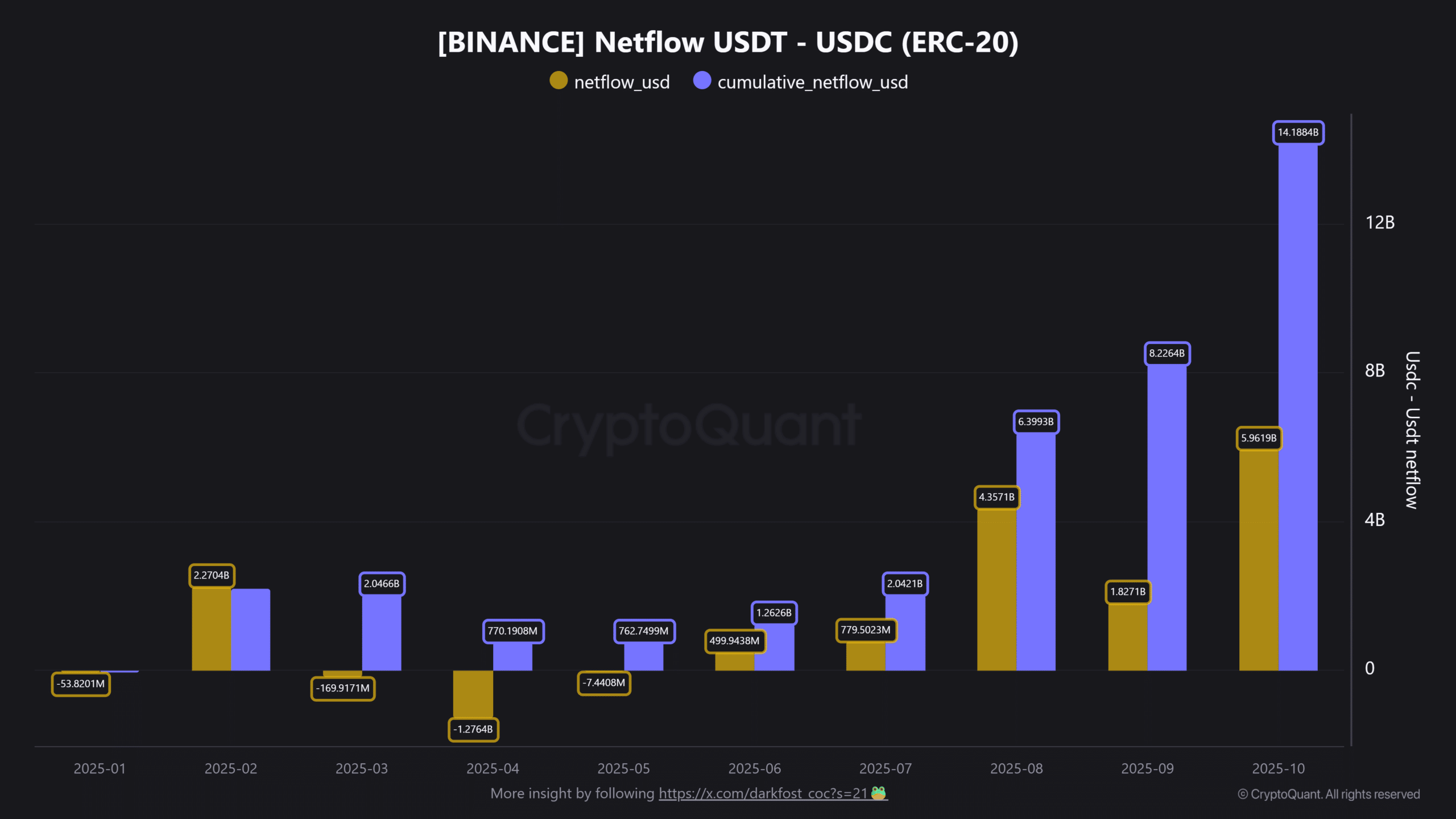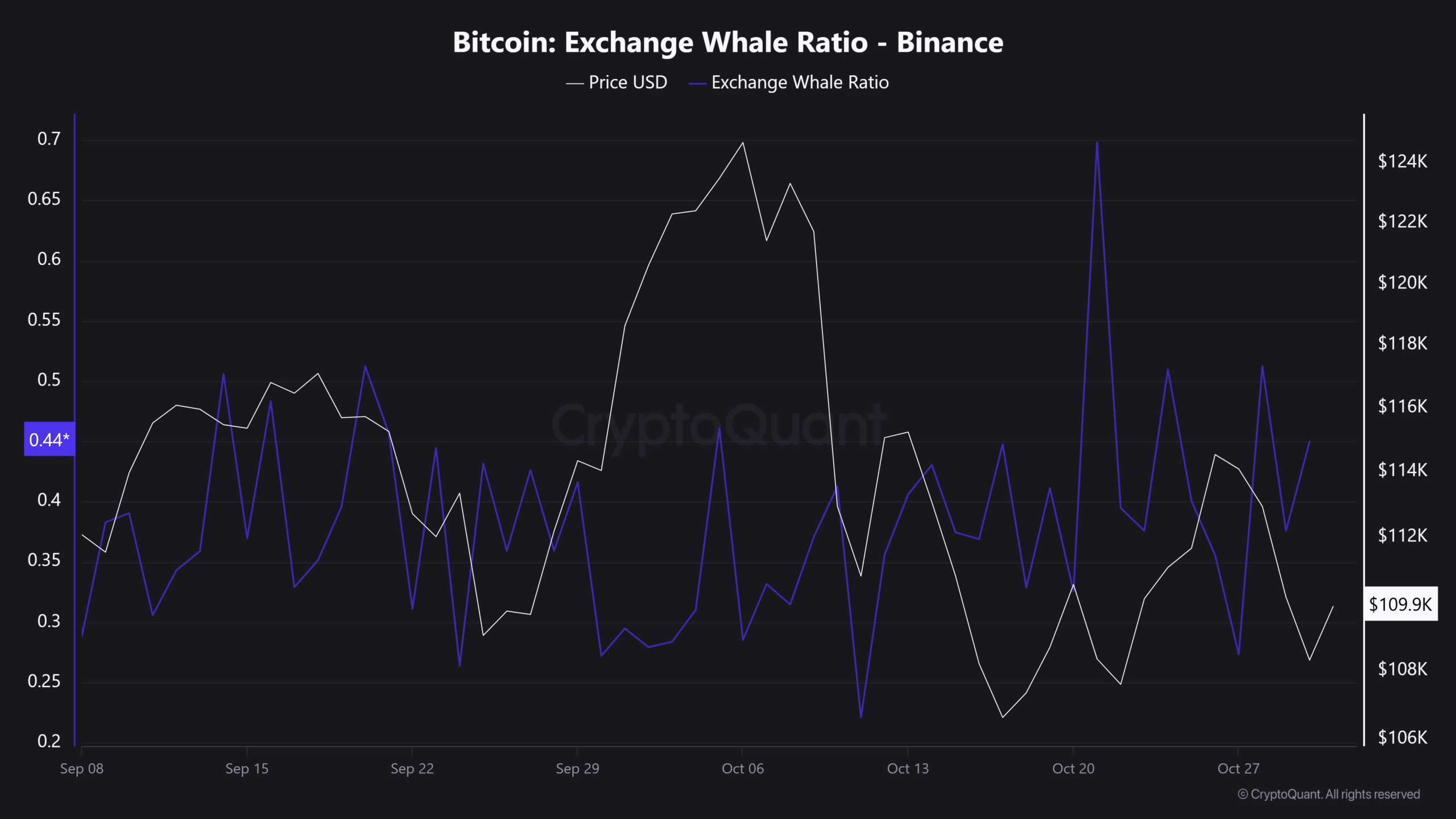Binance recorded a $6 billion stablecoin inflow in October 2025, marking its largest monthly surge this year and signaling strategic liquidity repositioning amid market volatility. This 227% increase in USDT and USDC flows indicates traders are preparing for potential rebounds rather than full exits.
-
October’s $6 billion inflow – Binance’s biggest in 2025, driven by USDT and USDC on ERC-20, boosting exchange liquidity.
-
Whale activity spiked to a nine-month high, with 70% of Bitcoin inflows from large wallets, showing institutional repositioning.
-
Market dip of 5.3% aligns with this data, per CryptoQuant analysis, suggesting a temporary pause in Q4 momentum rather than a downturn, with $4 billion in net new liquidity.
Discover Binance’s record $6 billion stablecoin inflow in October 2025 and its implications for crypto markets. Explore whale movements and liquidity signals for informed trading strategies today.
What is Binance’s $6 Billion Stablecoin Inflow in October 2025?
Binance’s $6 billion stablecoin inflow in October 2025 represents a significant surge in USDT and USDC deposits on the exchange, totaling nearly $6 billion and marking a 227% increase from the previous month. This influx, the largest monthly figure for Binance in 2025, equates to about $4 billion in new liquidity and underscores enhanced market depth during a period of heightened volatility. Data from CryptoQuant highlights how this movement reflects traders and institutions parking funds to navigate the 5.3% market correction, the sharpest since the first quarter.
How Does This Inflow Impact Crypto Market Liquidity?
The $6 billion stablecoin inflow into Binance strengthens overall liquidity, enabling smoother trading and hedging activities. According to CryptoQuant metrics, such surges often precede major price adjustments, as they provide the capital needed for rapid position entries or exits. In October 2025, this translated to a robust buffer against volatility, with stablecoins like USDT and USDC on the ERC-20 network seeing the bulk of the activity. Experts note that these flows, up 227% month-over-month, indicate a defensive yet opportunistic stance among market participants. Short sentences like this reveal the pattern: inflows build resilience. Historical data shows similar patterns have supported recoveries, such as in prior quarters when liquidity injections stabilized dips exceeding 5%.
Binance records 2025’s largest stablecoin inflow
Market volatility is showing up clearly in Binance’s flow data.
In October, the exchange logged nearly $6 billion in USDT and USDC inflows, a 227% surge from the prior month. That translates to roughly $4 billion in new liquidity, marking Binance’s largest monthly inflow of 2025.
Technically, this points to stronger market depth, which often comes before a larger price shift. With that in mind, the 5.3% market dip (the sharpest since Q1) looks more like a liquidity-driven move than random volatility.

Source: CryptoQuant
Simply put, Binance’s $6 billion inflow reflects strategic capital rotation.
Combined with the market dip, it showed investors weren’t exiting. Instead, they were moving funds in, likely to re-enter at stronger levels or reposition defensively to manage volatility, especially after October’s major wipeout.
Against this backdrop, the Q4 tailwind might not be gone just yet.
Stablecoins serve as essential tools in the cryptocurrency ecosystem, maintaining pegs to fiat currencies while facilitating efficient transfers. The October 2025 data from Binance illustrates their role in absorbing shocks during volatile periods. CryptoQuant’s on-chain analysis confirms that such inflows correlate with increased trading volumes, often by 20-30% in the following weeks. This pattern aligns with observations from financial analysts at firms like Glassnode, who emphasize stablecoins’ function in bridging traditional and digital finance.
Furthermore, the 227% growth in inflows highlights Binance’s dominant position in global crypto trading. With over 40% market share in spot and derivatives, as reported by industry trackers, this liquidity boost could influence broader market sentiment. Traders use these stable assets to sidestep direct exposure during corrections, preserving capital for opportune moments. The net effect? A more resilient exchange environment that supports sustained activity even amid a 5.3% dip.
Whales resurface as exchange activity picks up
Bitcoin’s [BTC] Exchange Whale Ratio supports this thesis.
On the 21st of October, the metric jumped to a nine-month high of 0.7% on Binance. This showed that roughly 70% of BTC inflows came from large wallets, showing that whales were actively using the exchange.
However, when you add Binance’s $6 billion stablecoin inflow to the mix, it signals high-volume repositioning, not a market exit. Simply put, whales and institutions are staying in the game, just adjusting strategy.

Source: CryptoQuant
That makes Binance’s stablecoin positioning a textbook liquidity signal.
As market stress built up, the exchange recorded a $6 billion inflow, reflecting a defensive strategy.
However, when paired with whale activity, it suggests large players are holding liquidity on standby, waiting for risk conditions to improve.
In this setup, the Q4 tailwind isn’t gone; it’s just paused until confidence returns.
Large holders, or whales, play a pivotal role in Bitcoin’s price dynamics, often moving thousands of BTC to exchanges for trading or liquidation purposes. The Exchange Whale Ratio reaching 0.7% on October 21, 2025, indicates concentrated activity from addresses holding over 1,000 BTC. CryptoQuant data reveals this as the highest in nine months, coinciding with the stablecoin surge. Financial experts, including those from Chainalysis, point out that such inflows typically signal preparation for leveraged positions rather than outright sales.
This whale resurgence aligns with broader on-chain trends, where exchange inflows rose by 15% week-over-week. When combined with the $6 billion stablecoin buffer, it forms a comprehensive picture of market adaptation. Institutions, managing billions in assets, use these moves to optimize portfolios amid uncertainty. The result is a balanced ecosystem where volatility is managed through diversified liquidity sources.
Stablecoins act as a double-edged sword in market structure.
On one side, they provide liquidity, allowing traders to hedge or re-enter positions without friction. On the other hand, rapid mint cycles tend to amplify volatility, as traders often view these shifts as early signs of market stress.
October, usually a bullish month, flipped its seasonal bias this year. However, stablecoin flows show that exchanges were positioned ahead of the move, setting up a key trend that could shape future market direction.
Frequently Asked Questions
What caused Binance’s $6 billion stablecoin inflow in October 2025?
Binance’s $6 billion stablecoin inflow in October 2025 stemmed from a 227% month-over-month increase in USDT and USDC transfers, driven by market participants seeking to bolster liquidity during a 5.3% correction. CryptoQuant data attributes this to strategic rotations by traders and institutions preparing for volatility management and potential re-entries.
Why are whales increasing activity on Binance amid inflows?
Whales are ramping up on Binance to reposition assets efficiently, as the Exchange Whale Ratio hit 0.7% on October 21, 2025, per CryptoQuant. This natural uptick allows large holders to leverage stablecoin liquidity for hedging, ensuring they maintain exposure without immediate selling pressure in a volatile environment.
Key Takeaways
- Record Inflow Milestone: Binance’s $6 billion stablecoin surge in October 2025, the largest this year, added $4 billion in net liquidity and enhanced market depth during a key dip.
- Whale Coordination: A nine-month high in the Bitcoin Exchange Whale Ratio at 0.7% shows large players actively managing positions alongside stablecoin flows for strategic repositioning.
- Volatility Resilience: These metrics suggest a pause in Q4 momentum, urging traders to monitor on-chain data for signs of renewed confidence and entry opportunities.
Conclusion
Binance’s $6 billion stablecoin inflow in October 2025, coupled with surging whale activity on the exchange, paints a picture of calculated market adaptation rather than panic. Supported by CryptoQuant’s detailed on-chain insights, this $6 billion influx and 0.7% whale ratio highlight liquidity’s role in navigating the 5.3% correction. As Q4 progresses, these signals point to potential stabilization, encouraging investors to stay vigilant for emerging trends in crypto market liquidity. Consider reviewing your portfolio strategies in light of these developments to capitalize on upcoming shifts.





